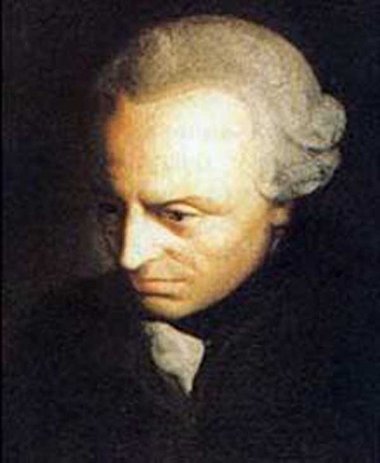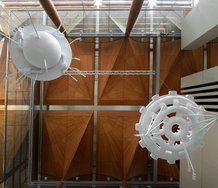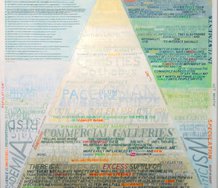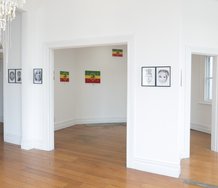Ralph Paine – 6 April, 2016
Rather than defining art itself as a higher category, what Baumgarten and Kant achieved with the concept/ideology of the aesthetic was to set up a transcendental judgment machine, one aimed at achieving the good, and one now deployed in the task of categorising the world of actual things and occasions in a new practical way: “Aesthetics manifests a free accord of the faculties which is linked, in a certain way, to a special interest for the beautiful; now, this interest predestines us to be moral, thus preparing the advent of the moral law or the supremacy of the pure practical interest.”
.
Art is not just the activity of established artists but a whole subjective creativity which traverses the generations and oppressed peoples, ghettoes, minorities …
- Felix Guattari, Chaosmosis: An Ethico-Aesthetic Paradigm
By and large, part one of this essay operates at the macro-level. To continue, a theory-path travelling the micro-level functioning of the modern art/aesthetic system is requisite. Comprising research on the day to day workings of the system’s complex mix of institutions, studies on the composition/disposition of its groups and personae, and how all the differing passions and desires interacted, fed-back, and developed, said theory-path is always already underway collectively. In what follows I offer a series of singular remarks on its proceeding:
Nation-state. In modernity aesthetic production gained an amazing nationalistic potential. Nietzsche’s late writings conceived art as a “will to power,” that is, as a force capable of generating not only fresh expressions of self, but also groups and peoples yet-to-come. (1) Did the modern nation-states co-opt/capture this will to power of art? Studies on the rise of landscape art during the early modern period, on its effect in shaping national consciousness in places such as Holland, England, or Japan, are imperative.
The English artist J. M. W. Turner is a good case in point. Turner gained a fortune selling large oil paintings of specific landscape scenes and sites of England to the rich, but also water colours and printed books of selected views of the nation to the new middle classes. W. J. T. Mitchell clarifies further: “[F]or Turner landscape doesn’t merely represent natural sites but creates a system of ‘circulating sites’ associated with the dominant class interests of burgeoning tourism, nationalism, imperialism … ” (2) In a more socio-political mode, and fifty years earlier, the artist William Hogarth engaged zealously in the production of a distinct Englishness - as opposed to continental European - in his paintings and prints. Pascale Casanova’s The World Republic of Letters (2004) and Franco Moretti’s The Bourgeois: Between History and Literature (2015) are essential indicators in regard literature and nation-states.
Current investigations into the experimental development of painting, cinema, architecture, etc. within the initial period of revolutionary Russia, into the uses and abuses of art in Nazi Germany and Fascist Italy, or art’s galvanizing effects in totalitarian Communist China in the 1960s, will no doubt be decisive in figuring how aesthetics gained such a highly developed and extremely powerful transformative effect within modern political formations. Here in Aotearoa/New Zealand there is continuing speculation on whether or not the modern nation-state developed a unique aesthetic, one shaping and directing some imagined identity as distinct from that of any other nation-state whatever; or as to whether the artistic nationalism of this south sea region of islands remains thoroughly European and/or North American in appearance and function. Doubtless ongoing immigration, tino rangitiratanga, and an official bi-culturalism cast massive effects.
Hence the importance of a contemporary reanalysis of nomadic, tribal, and other aesthetic systems at the micro-level. Here the fields of ethnology, archaeology, a revitalised art history, postcolonial studies, etc. come together with local forms of knowledge, local ontologies - what ethnologist-philosopher Eduardo Viveiros de Castro calls “indigenous conceptual worlds” - to provide hybridized, practical tools. Over the course of modernity many groups and individuals resisted its very workings.
In this regard and in a European context, we note William Morris and the Arts and Crafts Movement, and Guy Debord and the Situationists. Springing from the global “south” there are extensive accounts of resistant movements, counter-modern groups embracing “traditional” arts and crafts. Such accounts provide remarkable critiques of modern aesthetics, and possible ways toward the invention of alternatives. Yet here the problematic ground of “glocal” identity politics becomes ungrounded: given a universal tendency toward globalisation, how is it possible “to redefine the universal from the standpoint of [local] difference?” (3)
Contra the above - yet in the long term perhaps complimentary - in modernity an artwork became precisely that: an artwork. In other words, artworks now gained the ability to be removed or produced separately from any fixed or determining context. Artworks became autonomous-revolutionary-objectiles, that is to say, unique thing-events forever scanning the world for newer and newer more vital contexts. Nevertheless, these contexts were found/formed in two essential and intimately connected zones: first, the marketplace, with its commercial spaces and white cubes, dealer/gallerists, and bourgeois collectors; and second, the avant-gardes and movements, with their attendant theorist-journalists. Given time, the avant-gardes and movements and a thoroughly commercialised art production became indistinguishable, as hand in hand they set out in search of that defining essence/value of art, an essence/value more often than not posited as iconoclastic and hyper-commodified. Fights between the competing players erupted constantly. Today the history of this vast revolutionary/entrepreneurial dynamic, both the once secret agendas and the very public announcements, is researched, rewritten, replayed, restaged 24/7 as contemporary art. Perhaps the one essence/value modernism discovered - and then endlessly rediscovered - was that of its auto-repeating condition.
Alongside emerging art/music/architectural schools and academies, philosophical aesthetics grew up inside the modern university - Berlin University being the famous model. There, in the 1820s, G. W. F. Hegel delivered his influential Lectures on Aesthetics. In the course of the lectures Hegel sets up the idea of progress operating within the history of aesthetic production, that is to say, his art history is teleological. (4) All arts and crafts, in his view, had evolved over the vast span of human history towards a higher universal end or goal. The goal, Hegel theorized, was to be reached after many specific cycles of growth and decline, cycles isomorphic to the growth and decline of all the various cultures and civilisations along the way. The lectures are a beautifully complex and detailed description of this “dialectical” process, but in summing up he describes the process as a steady yet gradual ascension from sensation toward concept.
Was this Hegel’s way of asserting European philosophical production as the completed, most perfect form of aesthetic life? Perhaps - and doubtless conceptual art (and Peter Osborne’s recent notion of post-conceptual art) sits well with this paradigm - but whatever the case, Hegel’s lectures certainly award a lower status to all non-European aesthetic worlds, and to most European arts and crafts before modernity, with Ancient Greece being the one exception. Beware: Hegel’s ideas still haunt today’s art history departments.
Museums are habitually near perfect embodiments of Hegel’s historicisation of arts and crafts. These formidable institutions are powerhouses for the creation and measure of past and contemporary culture(s) and thus demand extreme close-up investigation and critique. The modern archetype is the Louvre in Paris. Once a royal palace, the building was taken over by the revolutionaries of 1789 to become a national treasure house “for the people.” Objects of all kinds - paintings, sculptures, furniture, antiquities, jewellery, tapestries, etc. - were sent there after removal from the chateaus, apartments, and houses of the aristocracy all over France. The doors of the new Louvre were thrown open and a “secular” public instantly created. Doubtless museums are a complex mix of institutions, yet all stand for the education, entertainment, and edification of some “imaginary” people. Today there’s a museum for everything and everything dreams of being in a museum: universal-archive-function. The contemporary art museum - and its mutant off-spring the biennale - is noteworthy vis-a-vis the recent exponential growth of global tourism: pilgrimages abound.
How did Baumgarten and Kant help instigate the modernist paradigm of art? This is a vexed question, as neither of these philosophers spoke of art in quite the sense that we use the term today. Perhaps the best way of assessing their input to modernist ideals is via the concepts of taste and beauty. Baumgarten described his aesthetics as “the science of cognition by the senses,” and stated that its goal, or its end, was the “attainment of beauty.” Yet notably, the beautiful for Baumgarten is always linked to the transcendent realm of “the good,” and hence the true goal of aesthetics is the acquiring of a certain moral taste, one defined by the ability to judge the necessary causal relations between certain things or occasions and certain frames of mind. In Baumgarten’s wake, those certain things or occasions which most consistently induced a beautiful and thus good frame of mind began to take on urgency for the European mind.
Kant conceived of humans as possessing certain combinations of “faculties”: understanding, imagination, judgment, etc. The faculties make possible - are the necessary condition for - the ordering and structuring of our perceptions of the sensual world into intelligible unities. That is to say, Kantian faculties enable a transformation of the disparate sensations we receive from a random outside into comprehensible wholes and parts on the inside. The artist, in Kant’s view, is unique in possessing the faculty of genius, this being a type of productive imagination or free spirit whose output is the attempted making of beautiful things and occasions. Genius is that which causes any given individual to be an artist, the innate possession of this faculty. The spectator, on the other hand, possesses the faculty of taste, an ability to discern what is beautiful, an ability, strangely enough, the artist does not possess, just as the spectator lacks genius. It’s as if with Kant that the spectator is required to act as a restraint on the artist’s blind and naturally transgressive ways. By judging the outputs of artistic genii, by keeping them in check as it were, the spectator ensures a continued production of the good. (5)
Consequently, rather than defining art itself as a higher category, what Baumgarten and Kant achieved with the concept/ideology of the aesthetic was to set up a transcendental judgment machine, one aimed at achieving the good, and one now deployed in the task of categorising the world of actual things and occasions in a new practical way: “Aesthetics manifests a free accord of the faculties which is linked, in a certain way, to a special interest for the beautiful; now, this interest predestines us to be moral, thus preparing the advent of the moral law or the supremacy of the pure practical interest.” (6) But in whose practical interest did aesthetics, along with its resultant higher category of art, begin to serve - the private interests of citizens, elite social groups, the “imaginary” peoples of nation-states, or a by now globalised/globalising market? Clearly all became inextricably interconnected.
Mass production/consumption. Modernist aesthetic judgment arose in the new sociality of a transformed public sphere, a new kind of space. (7) Modernity proceeded via the amazing expansion of a reconfigured arena of communication, or what today we name the mass media: newspapers, magazines, and book markets at first, then cinema, radio, television, etc. - the history of photography and mechanical reproduction are key here. (8)
If the modern persona of the artist was characterised as a new type of free spirit, an experimenter of the self or of individual expressiveness, his or her counter-persona was the professional critic, the journalist. The critic’s role à la Kant was to judge the aesthetic-moral successes and failures of artistic genius, that is, to judge whether any given artwork had achieved its necessary end. If the modern spectator always found him or herself in a crowd - a crowd becoming more and more diffuse, abstract, and thus impossible to define accurately - the critic began to represent this crowd, to speak on its behalf as it were, or began to act as a kind of legislator at the tribunal of community sense.
The problematic relationship between journalist critics and modern artists provides another significant field of study. Clearly today’s mass media are completely enmeshed or cast within the entire field of capitalist production, not only aesthetic production. Yet an aesthetic dimension spreads throughout all its functions and forms: contemporary aesthetic specialists, including artists, seem unable to operate outside the mass media’s often banalising sphere of influence. In fact, is there any outside? In this regard, what techno-decisive role have computers, smart phones, the Internet, etc. played in the recent rapid decline of modernist art and aesthetics? Regarding images, today everything seems reduced to the condition of porn: car-porn, war-porn, food-porn, art-porn, porn-porn . . .
Has modernity ended? Responding to this question in three different ways, we note three variations on the idea of the postmodern:
The first response is to answer in the negative, and thus to perceive the contemporary art world as a continuation of modernist ways, with postmodernism - defined as a set of particular critiques, styles, experiments - acting as a diffused and by now completely weakened version of an avant-garde, one simply competing alongside so many other players in a global marketplace of practices and products, theories and theory makers, and thus one fully conceivable within, and determined by, modernist paradigms.
The second response is to acknowledge that the modernist system of art has been completely subsumed within the rubric of a homogenised global culture. In other words, it would be to recognise the modernist notion of art as no longer providing any adequate category of power/potential with which to transform either individual or collective subjectivities in dynamic and interesting ways. A few decades back Jean Baudrillard suggested that “today what we are experiencing is the absorption of all virtual modes of expression into that of advertising.” (9) What did he mean? Doubtless we observe a rapid and radical blurring of the distinctions between art, craft, design, fashion, entertainment, etc. occurring, but what Baudrillard emphasises is the directionality of this transformation: all modes of expression are taking on the form of advertising, and not the other way around.
Here is how he describes advertising’s defining characteristics: a “triumph of superficial form, of the smallest common denominator of signification, degree zero of meaning,” “a simplified operational mode, vaguely seductive, vaguely consensual,” and possessing a “characteristic translatability.” For Baudrillard, then, everything is being produced as sound bite, bullet point, re-run, logo, catch phrase, stereotype, headline, cliché, etc. and therefore everything is effortlessly relayed and adapted for any cultural/corporate purpose - easily produced and consumed in other words. Baudrillard links the form of advertising directly to that of propaganda. Thus our second variation on the idea of the postmodern affirms the accomplishment of a globalised cultural market displacing art-as-ultimate concern.
Consequently, the third way of thinking the postmodern is to regard the previous scenarios as a two-fold collapse of the modernist paradigm, its corruption rather than the inauguration of anything liberatory or vital. It’s as if Hegel’s dialectic of aesthetics - his theory of the ascendancy of arts and crafts from sensation toward concept - has finally come true and completed itself in the form of today’s advertising, marketing, PR, and media firms large and small: the owners, executives, creative directors, copy-right holders, and specialist technicians of these corporations have not only “stolen” all operability of sensation from artists, but also all feasibility of concept from philosophers. (10)
Modern art and philosophy have reached a limit and crisis here, a limit and crisis internal to their ongoing sensual-conceptual viability. This limit and crisis now defines what art and philosophy always already were; it defines their present measure and calculation as pre-given powerless forms. Paradoxically the now accomplished non-viability of these forms is the very condition from which fresh viability will be created - is being created. To figure things in this manner is to incorporate a time wide open to the coming of different formations of aesthetic and philosophical flow, ones arising in the everyday worlds of “the generations and oppressed peoples, ghettoes, minorities … ” Yet not as any new ownership or will to power, but in a Giorgio Agamben-inspired sense simply as whatever-use.
Ralph Paine
(1) See Friedrich Nietzsche, “The Will to Power as Art” in The Will to Power, trans. Walter Kaufmann, New York: Vintage Books, 1968.
(2) Here Mitchell is introducing Elizabeth Helsinger’s wonderful essay “Turner and the Representation of England” in W. J. T. Mitchell ed., Landscape and Power, Chicago and London: The University of Chicago Press, 1994, 2002.
(3) Giacomo Marramao, The Passage West: Philosophy After the Age of the Nation State, trans. Matteo Mandarini, London and New York: Verso, 2012, 66.
(4) See Robert Wicks, “Hegel’s Aesthetics: An Overview” in Frederick C. Beiser ed., The Cambridge Companion to Hegel, Cambridge and New York: Cambridge University Press, 1993, 373.
(5) I am following Hannah Arendt’s analysis of Kant’s ideas as presented in her Lectures on Kant’s Political Philosophy, Chicago: The University of Chicago Press, 1982.
(6) Gilles Deleuze, Kant’s Critical Philosophy: The Doctrine of the Faculties, trans. H. Tomlinson & B. Habberjam, London: Athlone Press, 1984, 66.
(7) See Jurgen Habermas, The Structural Transformation of the Public Sphere: An Inquiry into a Category of Bourgeois Society, trans. Thomas Burger, Cambridge, Mass.: The MIT Press, 1991.
(8) See Walter Benjamin’s famous essay “Art in the Age of Mechanical Reproduction” in his collected volume Illuminations, trans. Harry Zohn, London: Fontana, 1973.
(9) Jean Baudrillard, Simulacra and Simulation, trans. S. Faria Glaser, Ann Arbor: The University of Michigan Press, 1994.
(10) See Gilles Deleuze and Felix Guattari, What is Philosophy?, trans. H. Tomlinson & G. Burchill, London & New York: Verso, 1994, 10-11.





 Advertising in this column
Advertising in this column Two Rooms presents a program of residencies and projects
Two Rooms presents a program of residencies and projects



This Discussion has 0 comments.
Comment
Participate
Register to Participate.
Sign in
Sign in to an existing account.